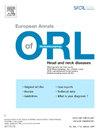优化桑尼布鲁克面部自动分级系统--利用面部地标提高深度学习网络的可靠性。
IF 2.4
4区 医学
Q2 OTORHINOLARYNGOLOGY
European Annals of Otorhinolaryngology-Head and Neck Diseases
Pub Date : 2025-01-01
DOI:10.1016/j.anorl.2024.07.005
引用次数: 0
摘要
目的:桑尼布鲁克面瘫分级系统(SFGS)是一套成熟的分级系统,用于评估单侧面瘫的严重程度和进展情况。SFGS 的自动化使研究人员、学生、接受培训的临床医生或其他未经培训的同事更容易使用 SFGS,并可在电子健康环境中实施。本研究调查了在先前开发的卷积神经网络(CNN)中添加面部地标层对自动 SFGS 可靠性的影响:方法:使用一个包含 116 名单侧周围性面瘫患者和 9 名健康受试者的现有数据集来训练带有新添加的面部地标层的 CNN。针对 SFGS 的 13 个元素分别训练了一个单独的模型,然后用于计算 SFGS 的子分数和综合分数。根据三位在面瘫分级方面经验丰富的临床医生计算出了自动分级系统的类内系数:结果:与之前的模型相比,增加了面部地标的 CNN 在所有综合评分方面的评分者间可靠性都有所提高。SFGS 综合评分的类内系数从 0.87 增加到 0.91,静息对称性子评分从 0.45 增加到 0.62,自主运动对称性子评分从 0.89 增加到 0.92,同步运动子评分从 0.75 增加到 0.78:将面部地标层整合到 CNN 中可显著提高自动 SFGS 的可靠性,达到与人类观察者相当的性能水平。这些结果是在不增加数据集的情况下取得的,凸显了将面部地标纳入 CNN 的影响。这些研究结果表明,带有面部地标的自动 SFGS 是评估单侧周围性面瘫患者的可靠工具,适用于电子健康环境。本文章由计算机程序翻译,如有差异,请以英文原文为准。
Optimization of the automated Sunnybrook Facial Grading System – Improving the reliability of a deep learning network with facial landmarks
Objective
The Sunnybrook Facial Grading System (SFGS) is a well-established grading system to assess the severity and progression of a unilateral facial palsy. The automation of the SFGS makes the SFGS more accessible for researchers, students, clinicians in training, or other untrained co-workers and could be implemented in an eHealth environment. This study investigated the impact on the reliability of the automated SFGS by adding a facial landmark layer in a previously developed convolutional neural network (CNN).
Methods
An existing dataset of 116 patients with a unilateral peripheral facial palsy and 9 healthy subjects performing the SFGS poses was used to train a CNN with a newly added facial landmark layer. A separate model was trained for each of the 13 elements of the SFGS and then used to calculate the SFGS subscores and composite score. The intra-class coefficient of the automated grading system was calculated based on three clinicians experienced in the grading of facial palsy.
Results
The inter-rater reliability of the CNN with the additional facial landmarks increased in performance for all composite scores compared to the previous model. The intra-class coefficient for the composite SFGS score increased from 0.87 to 0.91, the resting symmetry subscore increased from 0.45 to 0.62, the symmetry of voluntary movement subscore increased from 0.89 to 0.92, and the synkinesis subscore increased from 0.75 to 0.78.
Conclusion
The integration of a facial landmark layer into the CNN significantly improved the reliability of the automated SFGS, reaching a performance level comparable to human observers. These results were attained without increasing the dataset underscoring the impact of incorporating facial landmarks into a CNN. These findings indicate that the automated SFGS with facial landmarks is a reliable tool for assessing patients with a unilateral peripheral facial palsy and is applicable in an eHealth environment.
求助全文
通过发布文献求助,成功后即可免费获取论文全文。
去求助
来源期刊

European Annals of Otorhinolaryngology-Head and Neck Diseases
OTORHINOLARYNGOLOGY-
CiteScore
3.70
自引率
28.00%
发文量
97
审稿时长
12 days
期刊介绍:
European Annals of Oto-rhino-laryngology, Head and Neck diseases heir of one of the oldest otorhinolaryngology journals in Europe is the official organ of the French Society of Otorhinolaryngology (SFORL) and the the International Francophone Society of Otorhinolaryngology (SIFORL). Today six annual issues provide original peer reviewed clinical and research articles, epidemiological studies, new methodological clinical approaches and review articles giving most up-to-date insights in all areas of otology, laryngology rhinology, head and neck surgery. The European Annals also publish the SFORL guidelines and recommendations.The journal is a unique two-armed publication: the European Annals (ANORL) is an English language well referenced online journal (e-only) whereas the Annales Françaises d’ORL (AFORL), mail-order paper and online edition in French language are aimed at the French-speaking community. French language teams must submit their articles in French to the AFORL site.
Federating journal in its field, the European Annals has an Editorial board of experts with international reputation that allow to make an important contribution to communication on new research data and clinical practice by publishing high-quality articles.
 求助内容:
求助内容: 应助结果提醒方式:
应助结果提醒方式:


